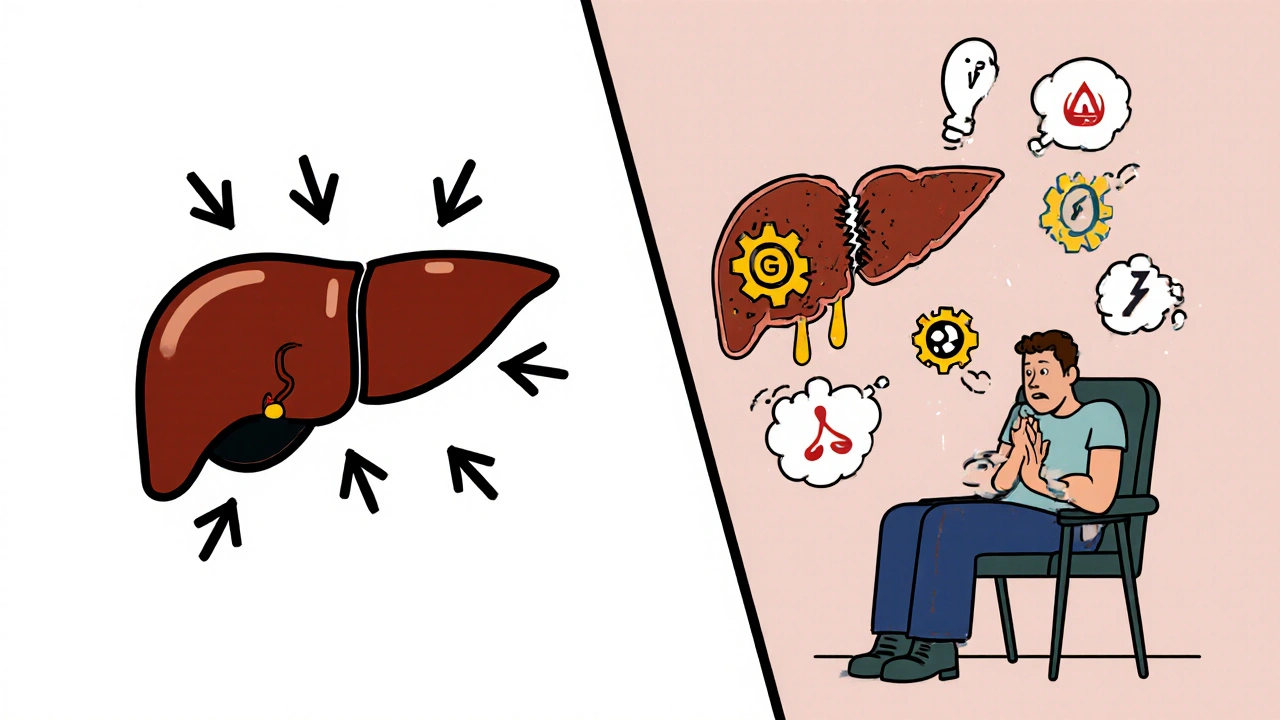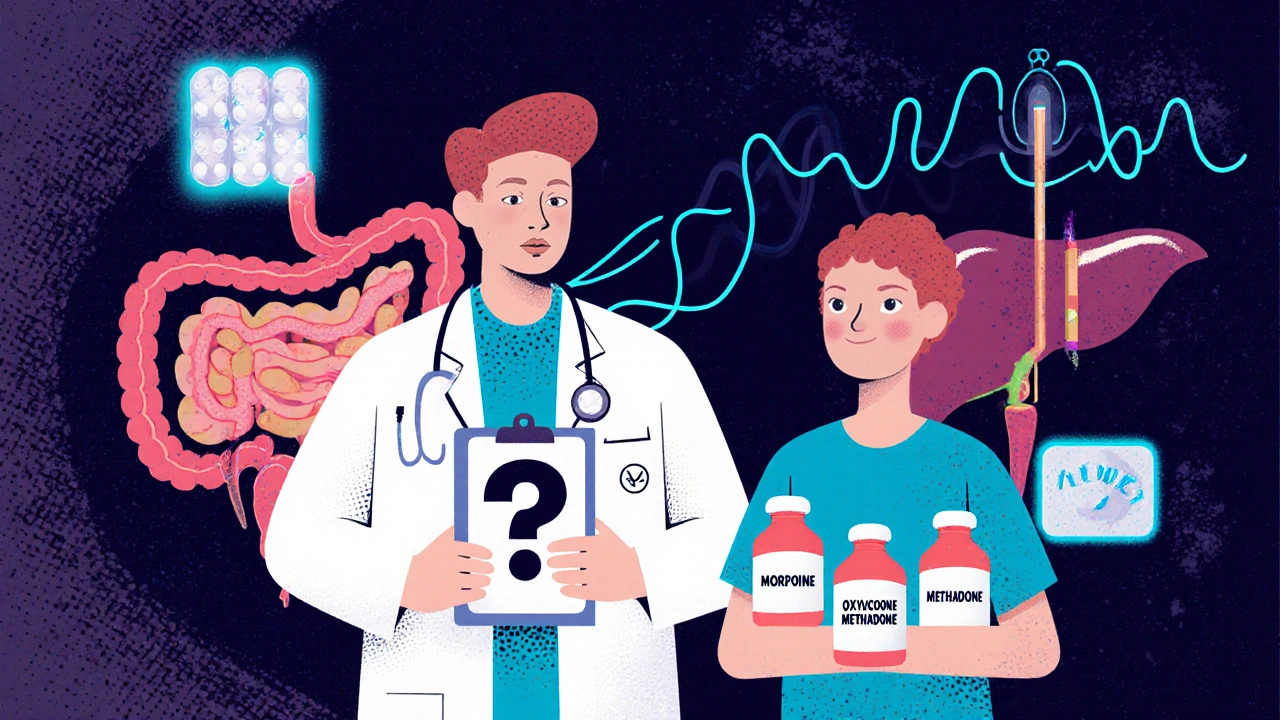Opioid Dosing Calculator for Liver Disease
Opioid Dosing Guidance
This tool calculates adjusted opioid doses based on liver function severity and specific medication type. Always consult with a healthcare provider before adjusting medications.
Adjusted Dose Recommendations
Please select liver severity, opioid type, and original dose to see recommendations.
When your liver is damaged, taking opioids isn’t just riskier-it can be dangerous in ways most people don’t expect. Opioids like morphine and oxycodone are broken down by the liver, and when that organ isn’t working right, these drugs don’t clear from your body the way they should. Instead, they build up. That’s when side effects turn serious: extreme drowsiness, slow breathing, confusion, and even coma can happen-even at doses that are normal for someone with healthy liver function.
How the Liver Normally Handles Opioids
The liver uses two main systems to process opioids: cytochrome P450 enzymes and glucuronidation. These are the body’s way of turning drugs into water-soluble compounds so they can be flushed out through urine or bile. Morphine, for example, gets turned into two metabolites: morphine-6-glucuronide (M6G), which helps with pain relief, and morphine-3-glucuronide (M3G), which can cause seizures and nerve damage. In a healthy person, M3G is cleared quickly. But if your liver is failing, M3G sticks around-and so does the risk.
Oxycodone works differently. It’s broken down by CYP3A4 and CYP2D6 enzymes. If those enzymes slow down-which happens in advanced liver disease-the drug doesn’t get processed at all. That means more of the original drug stays in your bloodstream. Studies show that in severe liver failure, oxycodone’s half-life jumps from the normal 3.5 hours to an average of 14 hours, and in some cases, it can stretch as long as 24 hours. That’s more than six times longer.
What Happens When the Liver Can’t Keep Up
Liver disease doesn’t just slow down opioid metabolism-it changes how your body reacts to them. In early-stage liver disease, the liver still tries to work, but it’s strained. In advanced disease, the enzymes that break down drugs become less active. For morphine, this means reduced clearance and longer time in the body. For oxycodone, peak levels in the blood can rise by 40%. That’s not a small change. It’s enough to push someone into respiratory depression, especially if they’re also taking other sedatives like benzodiazepines or alcohol.
People with non-alcoholic fatty liver disease (NAFLD) or diabetes often have lower CYP3A4 activity. That means opioids stick around longer. On the flip side, people with alcohol-related liver disease (ALD) have higher CYP2E1 activity. This enzyme can turn some opioids into more toxic byproducts. So two people with liver disease might have completely different risks depending on what caused their liver damage.
Which Opioids Are Riskiest?
Not all opioids are created equal when your liver is impaired. Morphine is one of the worst choices. Its reliance on glucuronidation makes it highly vulnerable to liver failure. Even mild liver impairment can cause M3G to accumulate, increasing the chance of neurological side effects. That’s why experts recommend cutting morphine doses by at least half in early liver disease-and using longer gaps between doses in advanced cases.
Oxycodone is also risky. In severe liver impairment, starting doses should be reduced to 30%-50% of the normal amount. Many doctors still prescribe standard doses, unaware of how dramatically metabolism changes. That’s a dangerous gap in practice.
Methadone is another problem. It’s broken down by several CYP enzymes, which sounds like it might make it safer. But because there’s no clear dosing guide for liver disease, doctors are flying blind. A dose that’s safe for one person might overdose another. There’s no reliable way to predict how someone’s liver will handle it.
On the other hand, buprenorphine and fentanyl may be better options. They’re metabolized differently and can be delivered through patches or injections that bypass the liver’s first-pass effect. That means less drug gets processed by the liver upfront. Still, research is limited. We don’t have solid dosing rules for either in advanced liver disease.

Long-Term Use and Liver Damage
It’s not just about how your liver handles opioids-it’s also about how opioids affect your liver. Chronic opioid use disrupts the gut microbiome. That imbalance triggers inflammation that travels through the portal vein straight to the liver. This gut-liver axis connection is now recognized as a major driver of worsening liver disease in people on long-term opioids. In someone with cirrhosis, that extra inflammation can speed up scarring and increase the risk of liver failure.
Studies have shown that people with chronic pain who use opioids long-term have higher rates of liver enzyme spikes, even if they don’t drink alcohol. The exact mechanism isn’t fully understood, but it’s clear: opioids aren’t just sitting idle in the liver-they’re actively contributing to damage.
Dosing Adjustments You Can’t Ignore
If you or someone you care for has liver disease and needs opioid pain relief, here’s what you need to know:
- Morphine: Reduce dose by 50% in mild to moderate liver disease. In severe disease, reduce dose by 75% and extend dosing intervals to every 8-12 hours.
- Oxycodone: Start at 30%-50% of the usual dose. Monitor closely for sedation and breathing changes. Never exceed 10 mg every 6 hours in severe impairment.
- Methadone: Avoid unless absolutely necessary. If used, start at 25% of the typical dose and titrate slowly under specialist supervision.
- Buprenorphine: Preferred option. Transdermal patches may be safer than oral forms. Start low (e.g., 5 mcg/hour patch) and increase cautiously.
- Fentanyl: Transdermal patches are better than IV or oral. Avoid in moderate to severe liver disease unless no alternatives exist.
There’s no one-size-fits-all rule. But the pattern is clear: lower dose, longer wait, closer monitoring. Always check liver function tests before starting or adjusting opioids. And never assume a dose that worked last month is still safe-liver function can decline quickly.

What’s Still Unknown
Despite decades of opioid use, we still lack solid guidelines for many drugs in liver disease. We don’t know exactly how much fentanyl accumulates in cirrhosis. We don’t have clear thresholds for when buprenorphine becomes risky. And we don’t know how opioid-induced inflammation affects different types of liver disease-like hepatitis C versus NAFLD.
Research is catching up, but slowly. One recent systematic review found that opioid-related adverse events are 2-3 times more common in patients with liver disease than in those with healthy livers. That’s not a small increase. It’s a red flag.
The biggest gap? No one has created a validated dosing calculator for opioids in liver disease. Doctors are still guessing. That’s why patient safety depends on awareness, not just prescriptions.
What to Do If You’re on Opioids and Have Liver Disease
If you’re taking opioids and have been diagnosed with liver disease-whether it’s from alcohol, fat, hepatitis, or something else-talk to your doctor immediately. Don’t wait for side effects to show up. Ask:
- Which opioid am I taking, and how is it processed?
- Has my liver function been tested recently?
- Should my dose be lowered?
- Are there safer alternatives?
Bring a list of all your medications-including over-the-counter painkillers and sleep aids. Many people don’t realize that acetaminophen (Tylenol) can also harm a damaged liver. Combining it with opioids makes the risk even worse.
Watch for signs of opioid toxicity: extreme sleepiness, difficulty waking up, slow or shallow breathing, confusion, or bluish lips. If you notice any of these, seek help right away. This isn’t something to wait out.
Liver disease doesn’t mean you can’t get pain relief. But it does mean you need a smarter, more careful approach. The goal isn’t just to manage pain-it’s to do it without putting your liver-or your life-at further risk.



Sharley Agarwal
24 November / 2025Just stop taking anything. Your liver doesn’t care about your pain. It just wants to die in peace.